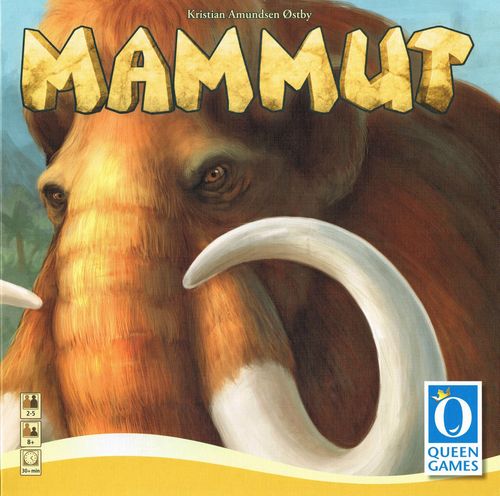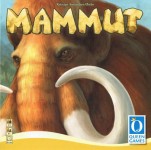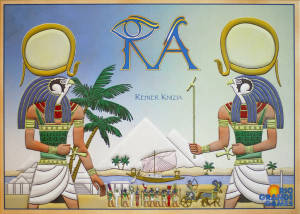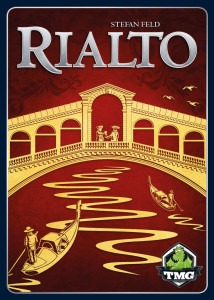- Learning time
- 20 minutes
- First play time
- 45 minutes
Mammut
Designed by: Kristian Amundsen Østby
In Mammut the players represent neanderthal cavemen divvying up the goodies from the day’s hunting and gathering. It’s a game of negotiation, where you want to push your luck ever-so slightly, but not enough to anger your fellow tribesman and have them snatch your haul off you.
At the start of the game a bunch of tiles are shaken up in a bag, then tipped onto the table. These represent what you’ve collected during the day. The starting player selects a bunch of tiles for themselves and separates them. The next player has a choice – they can do likewise with the remaining tiles, or they can take the tiles the previous player selected for themselves, judging them to be a bit greedy. To show you’re not greedy, if you take another players proposed share, you must return one tile to the central pile. This goes on until whichever player doesn’t yet have a share takes whatever remains in the centre.
But how do you judge what tiles to take? – Well, there are bunch of different tiles and they all score in different ways. Tusks get you two points each, whereas animal tiles (there are many different types) score for sets of them at the end of the game. Fire tiles don’t get you anything, but the player who has the fewest of them loses five points! Fur tiles move you along a fur track on the game board, where being ahead gets you points and being at the back loses you points. And so on.
Additionally, some tiles have a question mark on one side, so you can’t be sure what you’re getting if they have fallen question mark side-up onto the table. Although each player does start the game with two Axe cards, that allow them to have a sneaky look before deciding their share…
Finally it’s possible that two or more players may end up with the same amount of tiles in any category. That’s why the Shaman tile is important – whoever holds it breaks ties (and if the shaman holder isn’t involved in the tie, where players are sat in relation to them will be relevant). It’s a very unusual game in how it makes sharing a central mechanic, but Mammut works as a competition despite that.
The guru's verdict
-
Take That!
Take That!
A bit - players can take tiles from each other, but when doing so they make the share smaller for themselves.
-
Fidget Factor!
Fidget Factor!
Moderate on a first play, low thereafter, unless you have a real ponderer at the table.
-
Brain Burn!
Brain Burn!
There's a bit to think about here - when you take X tiles, you'll be sacrificing Y tiles to the other players. Playing completely random in this regard is probably not a long-term winning strategy.
-
Again Again!
Again Again!
Very easy to learn, quick to play, and the tile distribution has randomness (the ? tile sides) as do the tactics or whims of the players.











Sam says
It's not a game that surges into my list of favourites - but there is genuine tension in Mammut; a combination of tactics and mild brinkmanship during the divvying up that feels unique. It's easy to teach and fun to play. Unlike some games it doesn't outstay its welcome either.